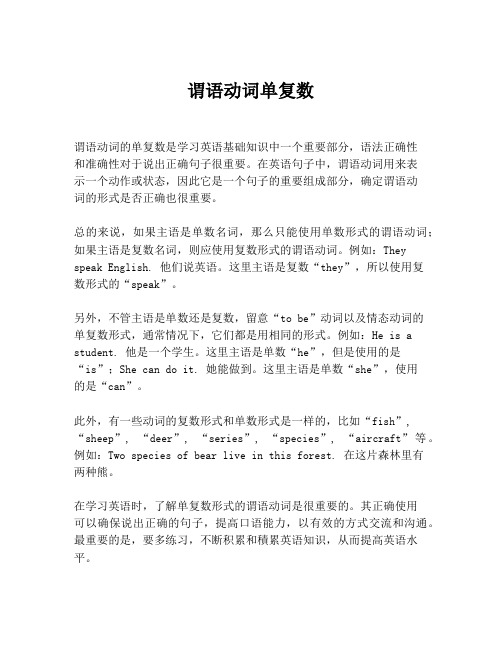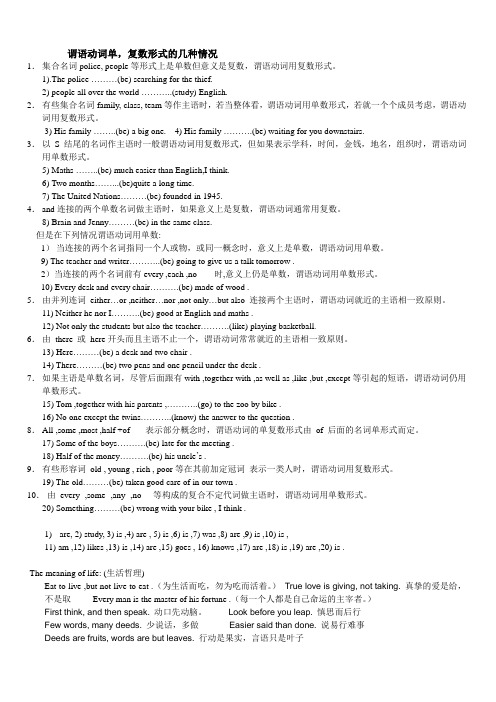谓语动词单复数用法
谓语动词用单数的情况

谓语动词用单数的情况 Company number:【WTUT-WT88Y-W8BBGB-BWYTT-19998】谓语动词用单数的情况1.动名词短语、不定式短语、名词性从句做主语,谓语用单数。
Buying clothes is often a time-consuming job because those clothes that a person likes are rarely the cones that fit him or her. (1987年考研题) To understand the situation completely requires more thought than has been given thus far.2.表示时间、距离、金额、重量、面积、体积、容积等度量的名词短语做主语时,谓语用单数。
Two weeks was too long Five times five makes twenty five3.一般用and连接的两个单词或短语做主语时候,谓语用复数,但是下面用and连接的主语表示一个概念,谓语用单数: law and order 法制 soap and water 肥皂水 a cup and saucer 茶杯碟子 fork and knife 刀叉 the needle and thread 针线 trial and error 反复尝试,不断摸索 horse and carriage 马车 time and tide 岁月 bread and butter 奶油面包 the ebb and flow 盛衰,潮涨潮落如: If law and order not preserved, neither the citizen nor his property is safe. A. is B. are C. was d. were 答案:A。
4.表示学科和某些疾病名称的名词是复数形式,作主语时候谓语动词用单数形式Linguistics is a branch of study on human language.5.有些名词形式上是复数,意义上是单数,根据意义一致原则动词用单数 The chaos was stopped by the police The news is a great encouragement to us A series of debates between the lectures was scheduled for the next weekend.6.用and 连接的成份表示一个单一概念时候,动词谓语用单数形式 Bread and butter is our daily food Time and tide waits for no man《和3同》二.谓语用复数情况1.由and, both …and, 连接的并列主语,和both ,a few, many ,several 等修饰语后面谓语动词通常用复数形式。
谓语动词何时用单数

谓语动词何时用单数1、可数名词单数形式作主语,谓语动词用单数形式。
This shirtis too small.这件衬衫太小了。
2、不可数名词作主语,谓语动词用单数形式。
Moneydoesn't always bringhappin ess.金钱并不总是带来幸福。
3、单个的专有名词作主语,谓语动词用单数形式。
The People's Republ ic of Chinawas founde d in 1949.中华人民共和国成立于1949年。
Shangh ai is the bigges t city in China.上海是中国最大的城市。
4、单数第三人称代词作主语,谓语动词用单数形式。
Does she come from Japan?她来自日本吗?My sister oftenwrites to me.我姐姐经常给我写信。
5、某些集体名词作主语,并且表示一个整体时,谓语动词用单数形式。
The Chines e footba ll team has played very well.中国足球队踢得非常好。
His family is a big one.他家人口多。
如果就其中一个成员来说,谓语动词用复数形式。
The family were out.全家人都出去了。
6、表示单一概念的、成对的名词作主语,谓语动词用单数形式。
Breadand butter is my favour ite food.涂奶油的面包是我最爱吃的食物。
All work and no play makesJack a dull boy.只工作不玩耍,杰克会变傻。
7、表示"时间"、"金钱"、"距离"、"重量"、"容量"的名词的复数作主语,谓语动词用单数形式。
谓语动词单复数变化规则

谓语动词单复数变化规则
嘿,朋友们!咱今天来聊聊谓语动词单复数变化规则这个超重要的事儿呀!
一般来说呢,主语是单数,谓语动词就用单数形式,就像一个人走在路上一样。
比如说“He runs every day.(他每天跑步。
)”这里的“runs”就是单数形式。
要是主语是复数呢,那谓语动词就得用复数形式啦,这就好像一群人在热热闹闹地玩耍。
例如“They play basketball.(他们打篮球。
)”“play”就是复数形式哟。
但有特殊情况哦,集合名词就得留意啦!像“family(家
庭)”“team(团队)”这些,得看具体所表达的意思来决定谓语动词的
单复数。
比如说“My family is very big.(我的家庭很大。
)”这里把家庭看作一个整体,就用单数。
但如果说“All my family like music.(我全家
人都喜欢音乐。
)”这时候就是复数啦,因为说的是家里的每个成员。
哎呀,是不是有点神奇呢?
还有不可数名词作主语,谓语动词通常也用单数呀,就像是“Water is important.(水很重要。
)”
这规则说起来好像不难,可实际运用中可得小心别出错呀!大家可得牢牢记住哦,不然说错了可就闹笑话啦,哈哈!。
谓语动词单复数

谓语动词单复数
谓语动词的单复数是学习英语基础知识中一个重要部分,语法正确性
和准确性对于说出正确句子很重要。
在英语句子中,谓语动词用来表
示一个动作或状态,因此它是一个句子的重要组成部分,确定谓语动
词的形式是否正确也很重要。
总的来说,如果主语是单数名词,那么只能使用单数形式的谓语动词;如果主语是复数名词,则应使用复数形式的谓语动词。
例如:They speak English. 他们说英语。
这里主语是复数“they”,所以使用复
数形式的“speak”。
另外,不管主语是单数还是复数,留意“to be”动词以及情态动词的
单复数形式,通常情况下,它们都是用相同的形式。
例如:He is a student. 他是一个学生。
这里主语是单数“he”,但是使用的是“is”;She can do it. 她能做到。
这里主语是单数“she”,使用
的是“can”。
此外,有一些动词的复数形式和单数形式是一样的,比如“fish”, “sheep”, “deer”, “series”, “species”, “aircraft”等。
例如:Two species of bear live in this forest. 在这片森林里有
两种熊。
在学习英语时,了解单复数形式的谓语动词是很重要的。
其正确使用
可以确保说出正确的句子,提高口语能力,以有效的方式交流和沟通。
最重要的是,要多练习,不断积累和積累英语知识,从而提高英语水平。
谓语动词单复数用法

谓语动词单复数用法:主谓一致是指:1)语法形式上要一致,即单复数形式与谓语要一致。
2)意义上要一致,即主语意义上的单复数要与谓语的单复数形式一致。
3)就近原则,即谓语动词的单复形式取决于最靠近它的词语,一般来说,不可数名词用动词单数,可数名词复数用动词复数。
There is much water in the thermos.但当不可数名词前有表示数量的复数名词时,谓语动词用复数形式。
Ten thousand tons of coal were produced last year.1 并列结构作主语时谓语用复数Reading and writing are very important.注意:当主语由and连结时,如果它表示一个单一的概念,即指同一人或同一物时,谓语动词用单数,and 此时连接的两个词前只有一个冠词。
The iron and steel industry is very important to our life.2 主谓一致中的靠近原则1)当there be 句型的主语是一系列事物时,谓语应与最邻近的主语保持一致。
There is a pen, a knife and several books on the desk..There are twenty boy-students and twenty-three girl-students in the class.2)当either… or… 与neither… nor,连接两个主语时,谓语动词与最邻近的主语保持一致。
如果句子是由here, there引导,而主语又不止一个时,谓语通常也和最邻近的主语一致。
Either you or she is to go.Here is a pen, a few envelops and some paper for you.3 谓语动词与前面的主语一致当主语后面跟有with, together with, like, except, but, no less than, as well as 等词引起的短语时,谓语动词与前面的主语一致。
主谓一致时,什么时候谓语用单数?什么时候用复数

主谓一致时,什么时候谓语用单数?什么时候用复数主谓一致:在英语句中,谓语受主语动支配,必须同主语在人称和数上保持一致。
*名词+as well as/no less than/but/except/with/like +其他名词,作主语时,谓语与前面的第一个名词一致.*few/a few/both/many/several+名词复数/of+名词复数+复数*不定代词/疑问代词(something/anything/anywhere/somewhere/where/when)+单数语法一致原则:句子谓语动词的数取决于该句子主语的数。
1。
“the+姓氏名词的复数形式”(---的成员)+复数2。
all/some/half/enough/two thirds +名词(单/复数)+单/复数 3.复数形式的名词:clothes/trousers/shorts(短裤)/glasses/scissors/gloves/chopsticks等+复数*计量单位(pair)+复数形式的名词+谓语取决于计量单位意义一致原则:谓语动词的单、复数形式,取决于主语所表达的概念。
1.集体名词:people/public(公共)/police/crew(船员)+复数2。
复数形式,单数意义。
(news/physics/maths/politics) 3.集合名词:class/family/team/Chinese/Japanese强调总体--单数;强调个体--复数。
The class has 45 students. The class are planting trees on the hill.4.时间、距离、价格、重量的复数名词/算式+单数Ten days is a long time.5.the +形容词“表一类人”+复数; The rich have much money.6.and/both--- and + 复数7。
one of/each of/none of/either of/neither of +名词+单数8.a number(许多) +n +复数;the number (---的数量)+n +单数9。
如何确定谓语动词的单复数形式

All the employees except the youngest one (work) very hard II .主语的“数”决定谓语动词的形式。
1.“不可数名词、可数名词单数、单数代词、不定式(短语)、动名词(短语)”或“从句”等作主语,用单数谓语形式。
e.g.①The work is important . 这项工作重要。
②To serve the country is our duty . 为祖国服务是我们的义务。
③How and why he left was a sad story . 他离开的经过和原因是一段伤心的经历。
2.复数的名词、代词一般接复数谓语形式。
e.g.①The children are taken good care of . 孩子们得到很好的照料。
②They have gone to Chengdu . 他们去成都了。
II. 以“and ”或“both… and”连接的并列主语:1.通常作复数用。
e.g.①Plastics and rubber never rot . 塑料和橡胶从不腐烂。
②What he says and what he does do not agree. 他言行不一致。
③Both Tom and I are fond of medicine . 我和汤姆都喜欢医学。
2.如果并列主语指的是“同一个”人(事、物、抽象概念),作单数用。
e.g.①The worker and writer has come . 这位工人作家来了。
②A cart and horse was seen in the distance . 远处能看见有一套马车。
③Truth and honesty is the best policy . 真诚是最好的策略。
3.“and”前、后的单数词语都有“each,every ,many ,a ,no”等修饰时,仍作单数用。
谓语动词单,复数形式的几种情况

谓语动词单,复数形式的几种情况1.集合名词police, people等形式上是单数但意义是复数,谓语动词用复数形式。
1).The police ………(be) searching for the thief.2) people all over the world ………..(study) English.2.有些集合名词family, class, team等作主语时,若当整体看,谓语动词用单数形式,若就一个个成员考虑,谓语动词用复数形式。
3) His family ……..(be) a big one. 4) His family ……….(be) waiting for you downstairs.3.以S结尾的名词作主语时一般谓语动词用复数形式,但如果表示学科,时间,金钱,地名,组织时,谓语动词用单数形式。
5) Maths ……..(be) much easier than English,I think.6) Two months……...(be)quite a long time.7) The United Nations………(be) founded in 1945.4.and连接的两个单数名词做主语时,如果意义上是复数,谓语动词通常用复数。
8) Brain and Jenny………(be) in the same class.但是在下列情况谓语动词用单数:1)当连接的两个名词指同一个人或物,或同一概念时,意义上是单数,谓语动词用单数。
9) The teacher and writer………..(be) going to give us a talk tomorrow .2)当连接的两个名词前有every ,each ,no 时,意义上仍是单数,谓语动词用单数形式。
10) Every desk and every chair……….(be) made of wood .5.由并列连词either…or ,neither…nor ,not only…but also 连接两个主语时,谓语动词就近的主语相一致原则。
- 1、下载文档前请自行甄别文档内容的完整性,平台不提供额外的编辑、内容补充、找答案等附加服务。
- 2、"仅部分预览"的文档,不可在线预览部分如存在完整性等问题,可反馈申请退款(可完整预览的文档不适用该条件!)。
- 3、如文档侵犯您的权益,请联系客服反馈,我们会尽快为您处理(人工客服工作时间:9:00-18:30)。
谓语动词单复数用法:
主谓一致是指:
1)语法形式上要一致,即单复数形式与谓语要一致。
2)意义上要一致,即主语意义上的单复数要与谓语的单复数形式一致。
3)就近原则,即谓语动词的单复形式取决于最靠近它的词语,
一般来说,不可数名词用动词单数,可数名词复数用动词复数。
There is much water in the thermos.
但当不可数名词前有表示数量的复数名词时,谓语动词用复数形式。
Ten thousand tons of coal were produced last year.
1 并列结构作主语时谓语用复数
Reading and writing are very important.
注意:当主语由and连结时,如果它表示一个单一的概念,即指同一人或同一物时,谓语动词用单数,and 此时连接的两个词前只有一个冠词。
The iron and steel industry is very important to our life.
2 主谓一致中的靠近原则
1)当there be 句型的主语是一系列事物时,谓语应与最邻近的主语保持一致。
There is a pen, a knife and several books on the desk..
There are twenty boy-students and twenty-three girl-students in the class.
2)当either… or… 与neither… nor,连接两个主语时,谓语动词与最邻近的主语保持一致。
如果句子是由here, there引导,而主语又不止一个时,谓语通常也和最邻近的主语一致。
Either you or she is to go.
Here is a pen, a few envelops and some paper for you.
3 谓语动词与前面的主语一致
当主语后面跟有with, together with, like, except, but, no less than, as well as 等词引起的短语时,谓语动词与前面的主语一致。
The teacher together with some students is visiting the factory.
He as well as I wants to go boating.
4 谓语需用单数
1)代词each和由every, some, no, any等构成的复合代词作主语,或主语中含有each, every, 谓语需用单数。
Each of us has a tape-recorder.
There is something wrong with my watch.
2)当主语是一本书或一条格言时,谓语动词常用单数。
The Arabian Night is a book known to lovers of English.
<<天方夜谭>>是英语爱好者熟悉的一本好书。
3)表示金钱,时间,价格或度量衡的复合名词作主语时,通常把这些名词看作一个整体,谓语一般用单数。
(用复数也可,意思不变。
)
Three weeks was allowed for making the necessary preparations.
Ten yuan is enough.
5 指代意义决定谓语的单复数
1)在代词what, which, who, none, some, any, more, most, all等词的单复数由其指代的词的单复数决定。
All is right. (一切顺利。
)
All are present. (所有人都到齐了。
)
2)集体名词作主语时,谓语的数要根据主语的意思来决定。
如family, audience, crew, crowd, class,
company, committee等词后用复数形式时,意为这个集体中的各个成员,用单数时表示该个集体。
His family isn't very large. 他家不是一个大家庭。
His family are music lovers. 他的家人都是音乐爱好者。
但集合名词people, police, cattle, poultry等在任何情况下都用复数形式。
Are there any police around?
3)有些名词,如variety, number, population, proportion, majority 等有时看作单数,有时看作复数。
A number of +名词复数+复数动词。
The number of +名词复数+单数动词。
A number of books have lent out.
The majority of the students like English.
6 与后接名词或代词保持一致
1)用half of, part of, most of, a portion of 等词引起主语时,动词通常与of后面的名词,代词保持一致。
Most of his money is spent on books.
Most of the students are taking an active part in sports.
2)在一些短语,如many a 或more than one 所修饰的词作主语时,谓语动词多用单数形式。
但由more than… of 作主语时,动词应与其后的名词或代词保持一致。
Many a person has read the novel. 许多人都读过这本书。
